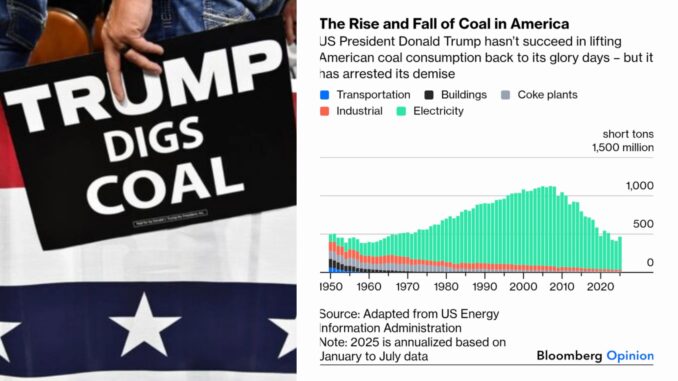
ENB Pub Note: This article is from Doug Sheridan’s LinkedIn, and we highly recommend subscribing.
Javier Blas writes in Bloomberg that Trump has confidently predicted the return of coal in America. Trump won’t resurrect coal consumption to its glory days, but he is likely to arrest its decline, freezing demand around current levels.
US coal demand will rise this year to about 465 million short tons, driven by higher electricity generation. That’s down 60% from 2007’s record high… but the increase of roughly 55 million tons from last year will be the largest annual jump in 40 years. That’s in part due to Trump’s policies, including using emergency laws to keep some coal-fired power stations open. Rising electricity demand, a trend that predates his re-election, is also playing its part.
The combination makes for energy statistics that seem to come from a bygone age. So far this year, coal-fired power generation in the US has increased by just over 60 GWhrs compared with the same period of 2024, eclipsing the increase in every other sector. Solar comes second at 54.7 GWh; wind is a distant third, at 7.7 GWh. Natural gas, nuclear and hydro have all seen declines.
Japan
The impact will be felt even more outside America than inside. For years, the US and Western Europe ostracized coal consumption, trailblazing a path against the fuel. By closing coal-fired power plants at home, they made keeping them open elsewhere in the industrialized world—Japan, South Korea and Taiwan, for example—more difficult. And they put pressure on emerging economies like China and India to stop building their own, or at least slow their expansion.
The vilification campaign had an impact. Global coal demand has kept increasing, but its growth over the last ten years is more a crawl than a boom. Still, it’s important to remember the world will still consume more coal this year than ever.
With coal moral-suasion gone in America and disappearing in Germany, the absence of pressure means the world’s power supplies will become increasingly dirty. To wit, China, which in 2021 promised to bring down demand during 2026 to 2030, now merely talks about coal consumption peaking at some point in the next five years.
In its forthcoming flagship World Energy Outlook, the International Energy Agency (IEA) will say that, under current policies, global coal demand won’t peak until 2030; the “gentle decline” that would follow shallower than previously expected, too. “Coal remains the largest source of global (electricity) generation for the next ten years,” it plans to say.
Our Take: This development is a real shame. Had the climate scientists and activists who decided they were qualified to redesign the world’s energy system over a decade ago by “electrifying everything with renewables”—and the politicians who listened to them—instead listened to energy industry professionals and emphasized nuclear and natural gas generation, the temptation for the US and other nations to turn to coal now would have not been nearly as great. Yet here we are.







Be the first to comment